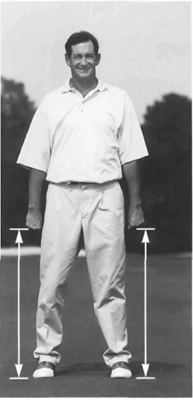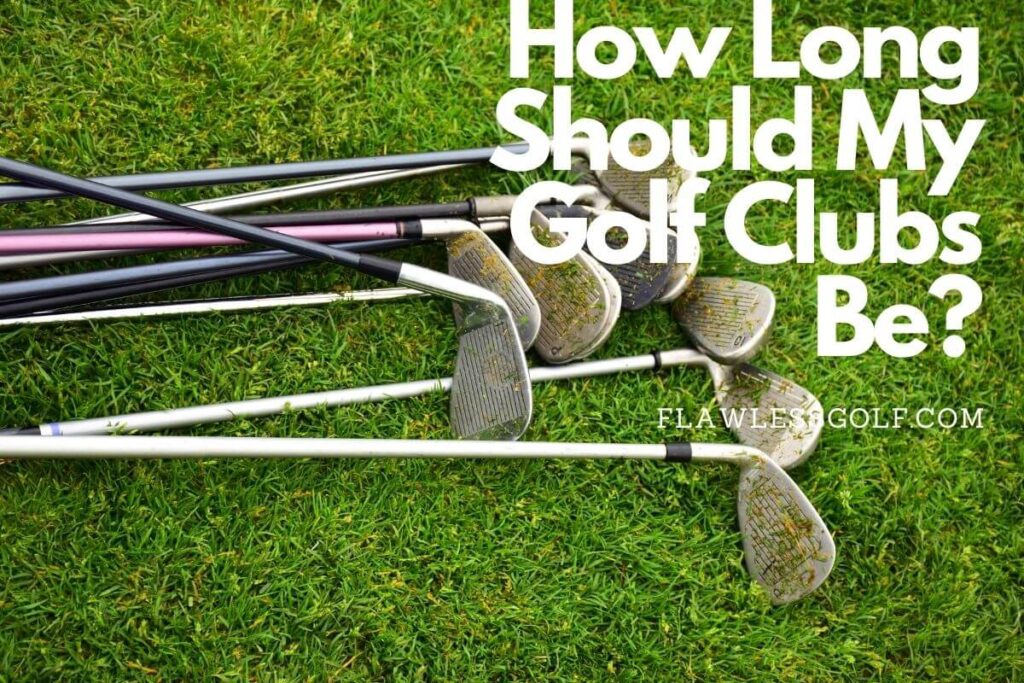Clubs have always been made for the average height individual, but over the years this has changed. For example, the center on the basketball team used to be 6½ feet tall. Nowadays that’s the guard’s height. So everyone is getting taller and clubs, in turn, are getting longer.
When I was growing up in the older days, a normal 2-iron was 38½ inches long. Now it is 39¼. So, if you are not average height, chances are your clubs don’t fit you. Here is what you should know about chosing the right length golf club:
How Long Should Golf Clubs Be For My Height?
The length of your back, arms, and legs are all factors in how long your clubs should be. But the most important aspect is the distance between your knuckles and the floor when your arms are hanging by your sides.
The distance from your knuckles to the ground is key when determining the length of your clubs.

Fingertips to floor is no good because you might have unusually large hands. Small or big hands and/or short or long fingers can skew the measurement. Besides, either or both indicates you need a different grip size, not shorter or longer clubs.
The measurements below can be used as a guideline in determining the length of club for your height.
Based on both your height and wrist to floor measurement.
| OVERALL HEIGHT | WRIST-TO-FLOOR MEASUREMENT | GOLF CLUB LENGTH ADJUSTMENTS |
|---|---|---|
| under 4’10” | under 25 inches | minus 2″ |
| 4’10” to 5″ | 25 to 27 inches | minus 1-1/2″ |
| 5’0″ to 5’2″ | 27 to 29 inches | minus 1″ |
| 5’2″ to 5’4″ | 29 to 34 inches | minus 1/2″ |
| 5’4″ to 5’7″ | 32 to 34 inches | minus 1/4″ |
| 5’7″ to 6’1″ | 34 to 37 inches | standard length in inches |
| 6’1″ to 6’2″ | 37 to 38.5 inches | plus 1/4″ |
| 6’2″ to 6’4″ | 38.5 to 40 inches | plus 1/2″ |
| 6’4″ to 6’6″ | 40 to 41 inches | plus 1″ |
| 6’6″ to 6’8″ | 41 to 42 inches | plus 1-1/2″ |
| above 6’8″ | above 42 inches | plus 2″ |
The table below shows the standard length of each golf club. Once you’ve decided your club length adjustment, add or subtract the amount from the standard length of the shaft.
| GOLF CLUB | LENGTH FOR MEN (steel/graphite shaft) |
LENGTH FOR WOMEN (steel/graphite shaft) |
|---|---|---|
| Driver | -/45 inches | |
| 1-wood | 43.5/44 inches | 42.5/43 inches |
| 3-wood | 42.5/43 inches | 41.5/42 inches |
| 5-wood | 41.5/42 inches | 40.5/41 inches |
| 7/9-wood | 40.5/41 inches | 39.5/40 inches |
| 2-iron | 39.5/40 inches | 38.5/39 inches |
| 3-iron | 39/39.5 inches | 38/38.5 inches |
| 4-iron | 38.5/39 inches | 37.5/38 inches |
| 5-iron | 38/38.5 inches | 37/37.5 inches |
| 6-iron | 37.5/38 inches | 36.5/37 inches |
| 7-iron | 37/37.5 inches | 36/36.5 inches |
| 8-iron | 36.5/37 inches | 35.5/36 inches |
| 9-iron | 36/36.5 inches | 35/35.5 inches |
| PW | 35.5/36 inches | 34.5/35 inches |
| SW | 35.5/36 inches | 34.5/35 inches |
| 1-hybrid | 41/41.5 inches | -/40.5 inches |
| 2-hybrid | 40.5/41 inches | -/40 inches |
| 3-hybrid | 40/40.5 inches | -/39.5 inches |
| 4-hybrid | 39.5/40 inches | -/39 inches |
| 5-hybrid | 39/39.5 inches | -/38.5 inches |
| 6-hybrid | 38.5/39 inches | -/38 inches |
| 7-hybrid | 38/38.5 inches | -/37.5 inches |
| 8-hybrid | 37.5/38 inches | -/37 inches |
| 9-hybrid | 37/37.5 inches | -/36.5 inches |
| 10-hybrid | 36.5/37 inches | -/36 inches |
| 11-hybrid | 36/36.5 inches | -/35.5 inches |
| 12-hybrid | 35.5/36 inches | -/35 inches |
Note: Other factors like skill level and physical limitations must be considered for proper fitting of golf clubs.
The most important aspects of any club are the shaft length and the lie. They work in conjunction. Lie angle affects how far the butt end of the club is up off the ground. If you add an inch to the length of a club you don’t really get the full inch because the shaft rises at an angle.
If you want to make your clubs effectively longer, you need to make them more upright, too. Always go in increments. A little at a time. For every degree more upright a club is, you effectively make it about of an inch longer.
That’s why, if your height, posture, and length of arms make me think you need longer clubs, I don’t only recommend you lengthen the shafts.
You need to make them more upright, too. Moving away from the ball isn’t necessarily going to help your swing. Every golfer needs a good posture (more on that later), the hands hanging down beneath the shoulders, with the bend forward from the hips around twenty degrees. Nice and comfortable.
At address, create an angle of about twenty degrees between your upper and lower body.

What To Look For?
The first indication that something needs to be done about the length of your clubs is a faulty posture.
Lie and length influence your posture. And your posture influences the plane of your swing and your ability to pivot your body correctly. So it follows that the lie of the club and the way that the clubface hits the ground influences the way the ball takes off and flies.
As I watch a player I always ask myself if he could sole the club properly on the ground if he did have the correct body angles.
Sometimes posture is bad because the player is trying to sole the club but can’t because his clubs don’t fit him.
The shape and depth of your divots can also tell you a great dealabout how well-suited you are to the clubs in your bag. For example, if you are making “toe deep” divots, then the lie of your clubs is too flat.
If they are “heel deep”—which is rare—your clubs are too upright. Most times, however, the divots are toe deep. That being the case, there are three possibilities. Either you are too tall, or your arms are too short, or your swing is too upright.
While there isn’t much you can do— barring surgery—about the first two, you have a choice with the third. You can work on flattening your action (difficult) or simply make your clubs more upright (easy). I recommend a combination of the two.
You can change your ball-flight dramatically just by changing the lie of your clubs. The flatter the lie, the more you will hit the ball to the right; more upright and the ball will go left.
The differences can be quite dramatic. If you take a 5-iron that is two degrees upright and hit the ball, say, 180 yards, then take another 5-iron, this one two degrees flat, and hit it 180 yards also, there could be as much as 20 yards difference left and right between the two balls.
Of course, that illustration wouldn’t hold true for long; only one or two swings. You’d soon start compensating. And that’s where inconsistency comes in. One compensation leads to another and another.
So never say just “lengthen the club.” It has to be “lengthen and adjust the lie.” If you need longer clubs, start with one degree upright and maybe a quarter inch longer.
Then another degree and another quarter inch. And so on. You never want to have a set an inch longer that isn’t two or three degrees upright.
The same thing when you go shorter. I never want to see clubs more than two degrees flat, no matter how short the person is. If the club gets excessively flat, it forces you to swing on too flat a plane and it gets difficult to make solid ball-turf contact.
Your club is just too close to the ground for too long a period of time if you develop a swing to match clubs that are more than two degrees flat.
Where you might go as much as four degrees upright, you never go more than two degrees flat. If you need a flatter club it’s better to go shorter.
Problem is, when you make a club shorter, it can cost some clubhead speed. The arc of the swing gets shorter and you can’t swing the club as fast. It is almost always better to have clubs a little long and/or upright as opposed to short and/or flat.



